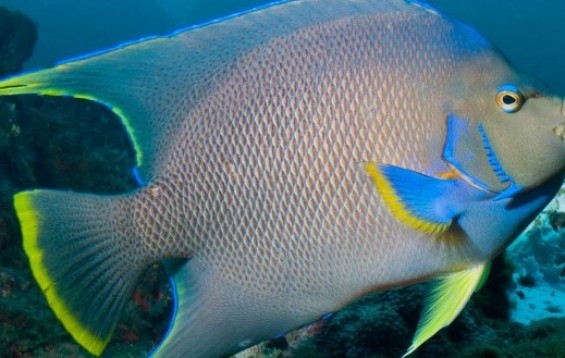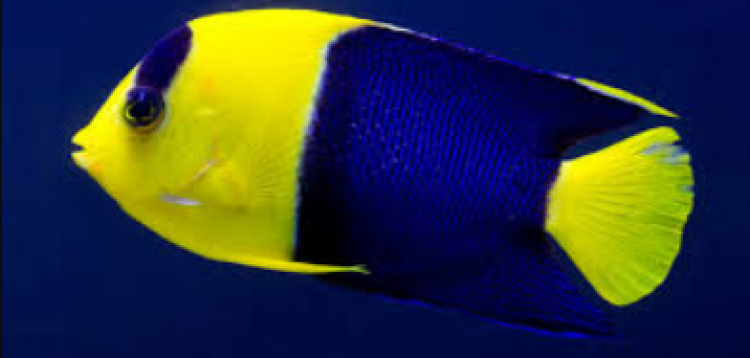- Name:
Blue Angelfish
(View AKA's) - Family: Pomancanthidae
- Species: Angel Large
- Scientific Name: Holacanthus bermudensis


General info about Blue Angelfish
The Blue Angelfish is commonly found in coastal reefs with turbid waters in Florida, and can also be found in deep reefs in the Gulf of Mexico. This blue-brown fish has trailing dorsal and anal fins that are blue with yellow-edges. Juveniles are dark blue with yellow highlights and bright blue bars on the body. They are often confused with the Queen Angelfish Holacanthus ciliaris. It can reach up to almost 15 inches (45 cm) in length, though the best size to obtain this Holacanthus species is between 2.5" to just under 5" for it to readily accept aquarium foods and acclimate. It can live for 20 or more years in captivity with good care.
Blue Angelfish Diet & Nutrition
This species is known to feed on sponges but may occasionally feed on tunicates, corals, and algae. Juveniles of this species are a cleaner fish feeding on the external parasites of other fishes. Adults may be fed with a varied diet containing sponge material and Spirulina. They may also be supplemented with small amounts of brine and mysis shrimps, along with finely chopped marine flesh.
Determining Sex of Blue Angelfish
Males are usually larger than females.
Breeding & Spawning Blue Angelfish
This species have not been bred in captivity, however, in the wild they are usually seen in monogamous pairs.
In spawning, the pair will slowly rise up in the water column bringing their bellies close to each other, and release their gametes for external fertilization. Eggs will hatch 15 to 20 hours after spawning. After 48 hours, the fish develops into a true larvae and will begin feeding on the plankton found in the water column.
Common Diseases with Blue Angelfish
If fed with plenty of meaty food can cause nutritional blindness to the Blue Angelfish at around 6-8 months after taken into captivity. It may also acquire White Spot Disease Cryptocaryon irritans, and Marine Velvet or Velvet Disease Oodinium ocellatum if tank conditions are not optimal. Viral infections like lymphocystis might also occur. Monogenetic flukes are the most common parasitic infections angelfish are prone to contracting.
Blue Angelfish Origin
This species is widely distributed in the Western Atlantic particularly in the waters of Bermuda, Bahamas and off southern Florida, USA to the Gulf of Mexico, including Yucatan, Mexico.
Caution with Blue Angelfish
The juveniles are strongly territorial, defending areas where they have set up a cleaning station which is usually a coral head or rocky area. Adult Blue angelfishes can be bullies to peaceful fish and fish that have a similar shape, color, or size and slow moving or stationary fish like frogfishes and scorpionfishes. Blue angelfishes should be added in the tank last.
Blue angelfishes are not 100% reef tank safe as adults are known to nip on corals and tubeworms.
Acclimating Blue Angelfish
An adult Blue angelfish will need a 180 gallon tank at the minimum with plenty of rock works for multiple hiding places and grazing. Juveniles may be grown out in smaller tanks, but after only a few months their growth will render smaller tank useless. Obtain a small juvenile between 2.5" to just under 5" for best success, since they will be the size most likely to adapt to prepared foods.
Original Detail
| Name | Species | Family | Scientific Name | More Detail | Added by |
|---|---|---|---|---|---|
| Blue Angelfish | Angel Large | Pomancanthidae | Holacanthus bermudensis | The Blue Angelfish is commonly found in coastal reefs with turbid waters in Florida, and can also be found in deep reefs in the Gulf of Mexico. This blue-brown fish has trailing dorsal and anal fins that are blue with yellow-edges. Juveniles are dark blue with yellow highlights and bright blue bars on the body. They are often confused with the Queen Angelfish Holacanthus ciliaris. It can reach up to almost 15 inches (45 cm) in length, though the best size to obtain this Holacanthus species is between 2.5" to just under 5" for it to readily accept aquarium foods and acclimate. It can live for 20 or more years in captivity with good care. |
PalaciosAn |
Changed by users
| Submitted Date | Submitted By | Status | Action |
|---|


